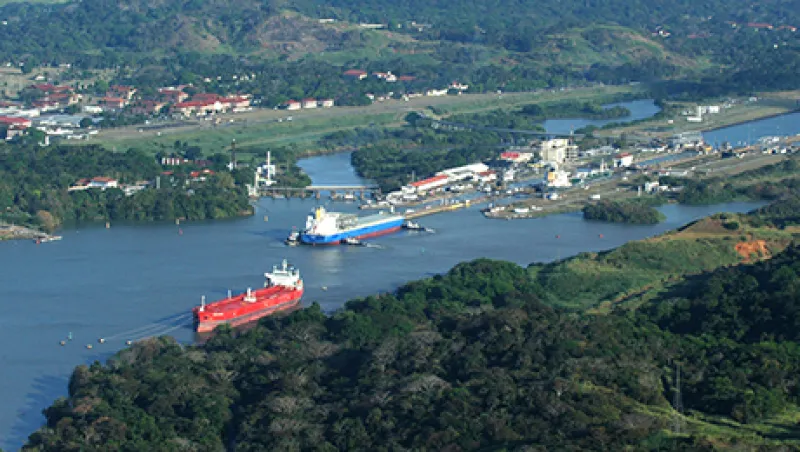In December, banking on increased volumes of cargo passing through the soon-to-be-expanded Panama Canal, Monmouth Real Estate Investment Corp. spent $18.4 million on an industrial building near the Port of New Orleans.
The real estate investment trust owns more than 14 million square feet of warehouses in Florida, Illinois, Ohio, Texas and other states, but the deal for a 175,000-square-foot building leased to FedEx Ground Packaging System marked its first acquisition in Louisiana. Perhaps reflecting uncertainty about how the wider canal might affect trade routes, there has been relatively little private real estate investment so far.
Eugene Landy, chairman of the Freehold, New Jersey–based Monmouth REIT, says the deal reflects his forecast that a wider Panama Canal will reshape shipping routes for consumer goods arriving in the U.S. Much of the cargo shipped from China and other Asian manufacturing hubs lands at the ports of Los Angeles and Long Beach, but Landy explains that importers want an alternative to California’s congestion, regulation and high labor costs.
“Shippers who have a second option will tend to go to states that are more business-friendly,” he says. “People prefer Texas, Mississippi, Alabama and Florida to California.”
For years investors have eyed the long-delayed project in Central America, but not everyone sees a wider, deeper Panama Canal as a game changer for U.S. supply chains. “It’s an incremental change,” says Tim Feemster, managing principal at Foremost Quality Logistics, a consulting firm in Dallas. “It’s going to be gradual.”
The $5.25 billion expansion of the Panama Canal, which began in 2007, will allow bigger boats to reach ports on the Atlantic and Gulf coasts. Now the largest ship that can squeeze through the canal holds about 5,000 containers. After the expansion, due for completion in April, huge ships with as many as 14,000 containers will be able to navigate the waterway.
Today such big boats stop in Los Angeles or Long Beach, where their cargo is unloaded and much of it reloaded onto trains headed east to the greatest concentrations of the U.S. population. Some 59 percent of Americans live in states east of the Mississippi River, according to U.S. Census data.
A wider canal means that cargo could travel by ship to an East Coast port and then move by train for a shorter distance. “Water transport is the cheapest form of transport,” Landy says. “The basic efficiency of the canal is that you double the size of the ship, but you only increase fuel consumption by 50 percent.”
This vision of a shift in cargo traffic has sparked a spending spree at East Coast ports. Atlantic and Gulf Coast ports have planned to invest $29 billion in infrastructure improvements from 2012 through 2016, according to the Alexandria, Virginia–based American Association of Port Authorities. Ports from New York to Miami to Houston have been deepening channels, upgrading container facilities and otherwise preparing for the arrival of megaships. The ports of Norfolk, Virginia, and Baltimore are ready for post-Panamax ships, and those of Houston, Miami and New York–New Jersey are nearing completion of improvements that will allow for the big vessels, according to Fitch Ratings.
But not every port is poised to cash in, Feemster says. He predicts that Charleston, South Carolina; Norfolk; and New York–New Jersey will see increased cargo volumes. Miami, however, is unlikely to win new traffic because of its distance from East Coast population centers. For now, the Port of Savannah, Georgia, is the second-busiest (by container traffic) East Coast port after New York–New Jersey, but it’s unclear how it will cope with a distinct topographic disadvantage: To get there, ships must travel some 20 miles up the Savannah River.
Bill Diehl, president of the Greater Houston Port Bureau, a nonprofit group that tracks shipping in and out of the ship channel, says a deeper Panama Canal does nothing to drive demand for consumer goods in the U.S. He warns that it’s easy to overstate the effect of an infrastructure improvement, no matter how massive: “Just because there’s a new road to Walmart doesn’t mean I’m going to buy more stuff from Walmart.”
Aside from the occasional dockworker strike at West Coast ports, most logistics professionals are happy with the current pattern of moving goods by water to California and then by rail to the rest of the country, Diehl contends. “In reality, what most supply chain people want is predictability, rather than better, faster, cheaper,” he says. “Moving cargo through the Port of Los Angeles is predictable, so you’ve got to beat them pretty good with better, faster, cheaper.”
As of 2013 the ports of Los Angeles and Long Beach dominated the U.S. cargo market. They brought in 14.6 million containers that year, according to the Washington-based World Shipping Council. The largest East Coast port, New York–New Jersey, tallied 5.5 million containers.
But Landy believes it’s only a matter of time before the East Coast begins to lure containers that once landed in California. “At what point does it tip? Nobody knows that,” he says. “If you assume even a small change, it’s going to be a significant shift.”






